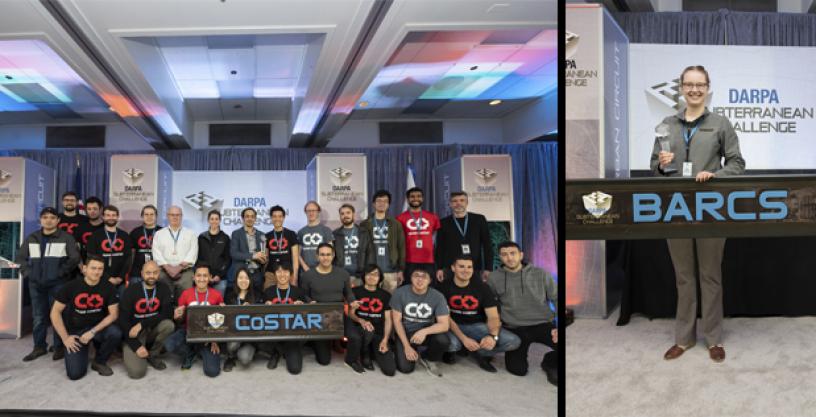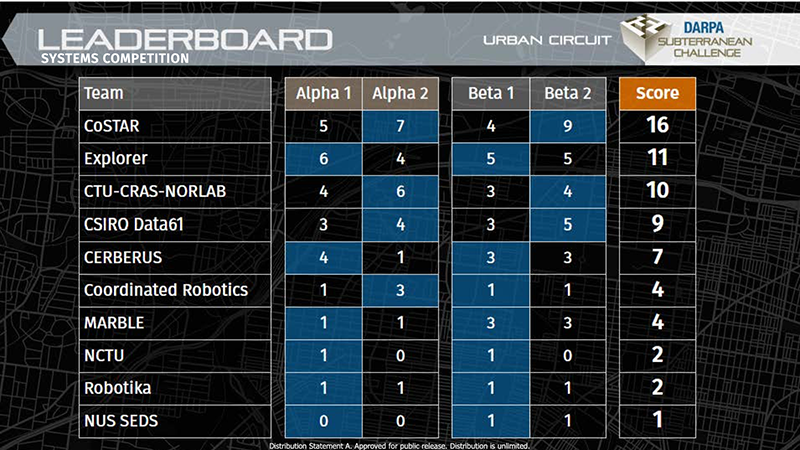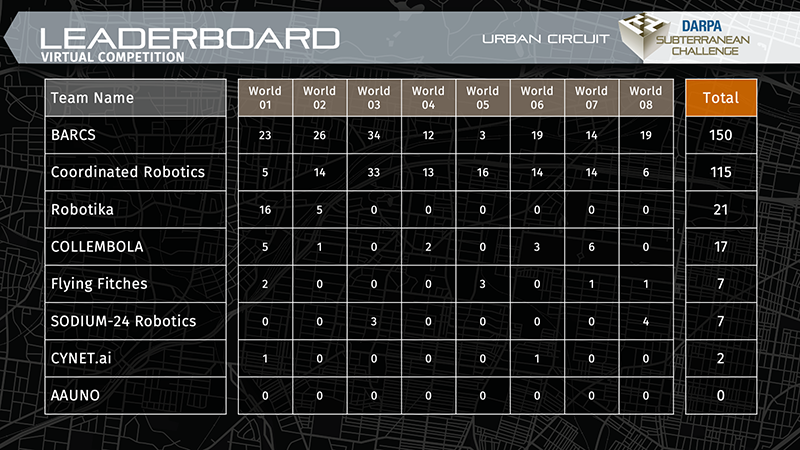CoSTAR posted highest overall score for Systems competition; BARCS took first place in Virtual competition

Feb 27, 2020
The ability to traverse vertical spaces proved key to success in the Subterranean (SubT) Challenge Urban Circuit. CoSTAR took the top spot in the Systems competition, while BARCS topped the leaderboard in the Virtual competition. Extending their performance from the Tunnel Circuit, CTU-CRAS-NORLAB earned the highest score among self-funded teams and the $500,000 prize. Also repeating success from the Tunnel Circuit, Coordinated Robotics earned the self-funded first prize in the Virtual competition, taking home $250,000.
In the Systems competition of the Urban Circuit, 10 teams navigated two courses winding through an unfinished nuclear power plant in Elma, Washington, Feb. 18-27, 2020. DARPA designed the courses to represent complex urban underground infrastructure. The Virtual competition with eight teams took place Jan. 23-30, with results announced Feb. 27. Teams from eleven countries participated across the Virtual and Systems competitions in the Urban Circuit.
“Teams are under tremendous pressure in the SubT Challenge, not just because of the prize money at stake, but because of the significance of winning a DARPA Grand Challenge, events that have a history of jumpstarting innovation,” said Dr. Timothy Chung, program manager for the Subterranean Challenge in DARPA’s Tactical Technology Office. “At the core of the SubT Challenge is the mission to face an unknown environment and respond to changing situations.”
The focus turns now to the Cave Circuit, set for August 2020. DARPA will announce the location about three months prior to the start of the event. DARPA-funded and self-funded teams compete side-by-side throughout the Subterranean Challenge. Only self-funded teams are eligible for prizes in the Circuit Events, but they must finish in the top six overall for the Systems competition and top five overall for the Virtual competition. All qualified teams are eligible for prizes in the Final Event.
“We knew heading into the Urban Circuit that verticality would be one of the significant obstacles. Teams that traveled between floors, either flying, walking, or rolling, found more artifacts,” said Dr. Chung. “Teams designed their approaches to tackle uncertainty up front, and then toward the end of the Urban Circuit, we saw them put their platforms out there and take more risks, I look forward to seeing how they adapt for the Cave Circuit.”
The final scores were as follows:
Systems
- 16: CoSTAR (Collaborative SubTerranean Autonomous Resilient Robots), DARPA-funded
- 11: Explorer, DARPA-funded
- 10: CTU-CRAS-NORLAB (Czech Technical University in Prague - Center for Robotics and Autonomous Systems - Northern Robotics Laboratory), self-funded winner of $500,000 first place prize
- 9: CSIRO Data61, DARPA-funded
- 7: CERBERUS (CollaborativE walking & flying RoBots for autonomous ExploRation in Underground Settings), DARPA-funded
- 4: Coordinated Robotics, self-funded winner of the $250,000 second place prize
- 4: MARBLE (Multi-agent Autonomy with Radar-Based Localization for Exploration), DARPA-funded
- 2: NCTU (National Chiao Tung University), self-funded
- 2: Robotika, self-funded
- 1: NUS SEDS, (National University of Singapore Students for Exploration and Development of Space), self-funded

Virtual
- 150: BARCS (Bayesian Adaptive Robot Control System), DARPA-funded
- 115: Coordinated Robotics, self-funded winner of the $250,000 first place prize
- 21: Robotika, self-funded winner of the $150,000 second place prize
- 17: COLLEMBOLA (Communication Optimized, Low Latency Exploration, Map-Building and Object Localization Autonomy), DARPA-funded
- 7: Flying Fitches, self-funded winner of the $100,000 third place prize
- 7: SODIUM-24 Robotics, self-funded
- 2: CYNET.ai, self-funded
- 0: AAUNO, self-funded

Systems teams in the Urban Circuit completed four total runs, two 60-minute runs on each of two courses, Alpha and Beta. Each course included 20 artifacts, all representing items found in an urban underground setting. Teams earned points by accurately identifying artifacts within five meters. To break the leaderboard tie between Coordinated Robotics and MARBLE, officials followed the first tiebreaker rule using the earliest time the last artifact was successfully reported, averaged across the teams’ best runs.
Virtual teams submitted solutions that SubT Challenge officials then tested across eight courses. Once the teams submitted their solutions, they executed autonomously without any input or adjustments from human operators. As in the Systems competition, Virtual competitors earn points by correctly identifying artifacts within five-meter accuracy. To break the leaderboard tie between Flying Fitches and SODIUM-24 Robotics, officials followed the first tiebreaker rule using the earliest time the last artifact was successfully reported, averaged across all of the teams’ runs.
For additional information on the DARPA Subterranean Challenge, please visit www.subtchallenge.com. Email questions to SubTChallenge@darpa.mil.
Image Caption: Final leaderboards from Subterranean Challenge Urban Circuit
# # #
Media with inquiries should contact DARPA Public Affairs at outreach@darpa.mil
Associated images posted on www.darpa.mil and video posted at www.youtube.com/darpatv may be reused according to the terms of the DARPA User Agreement, available here: http://go.usa.gov/cuTXR.
Tweet @darpa
